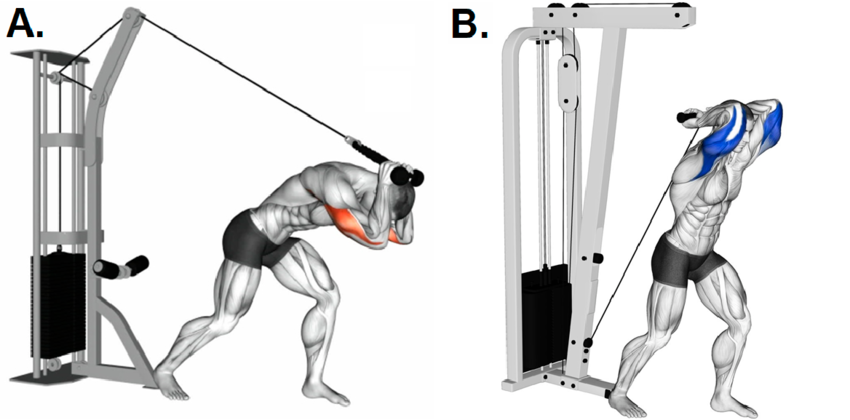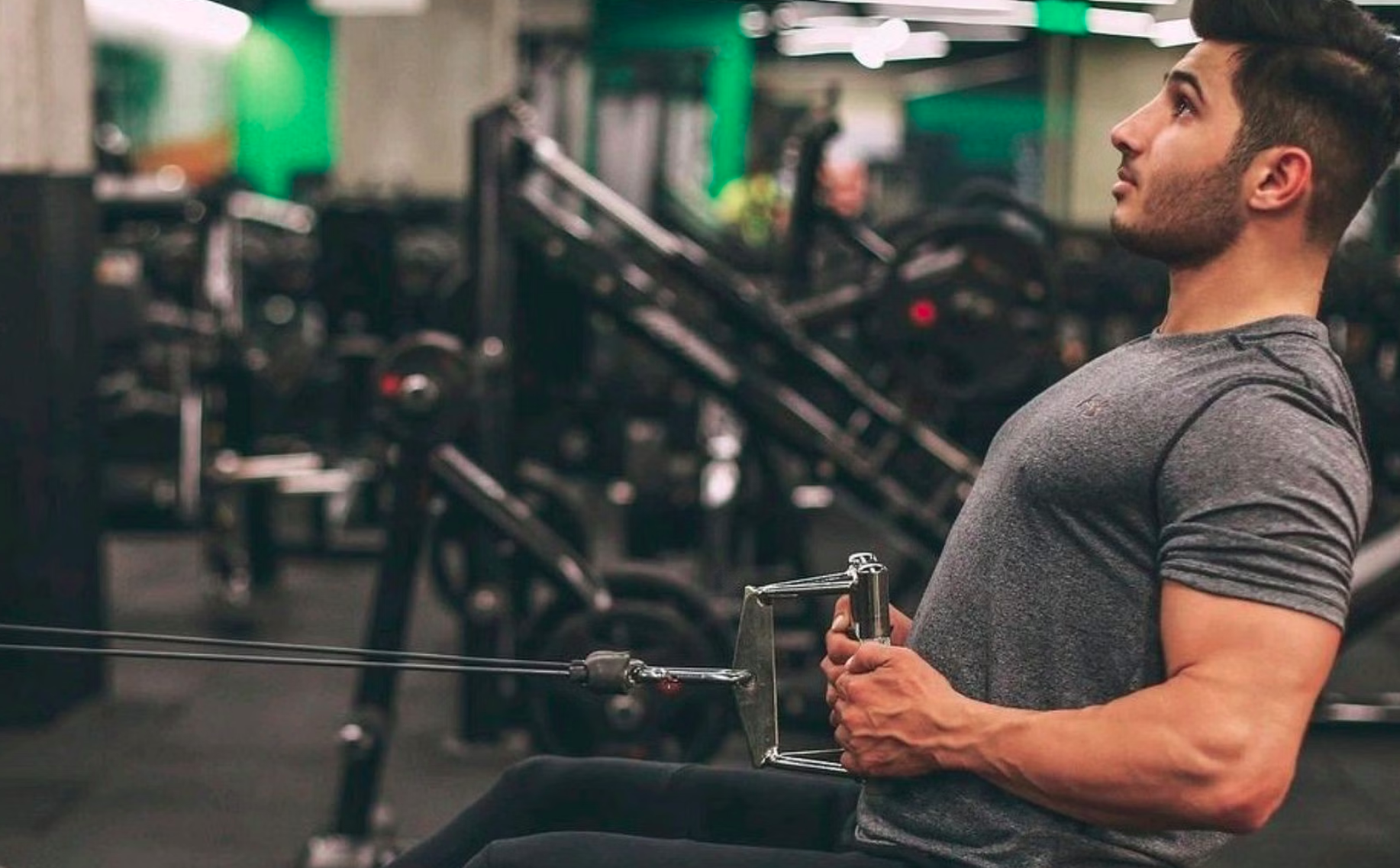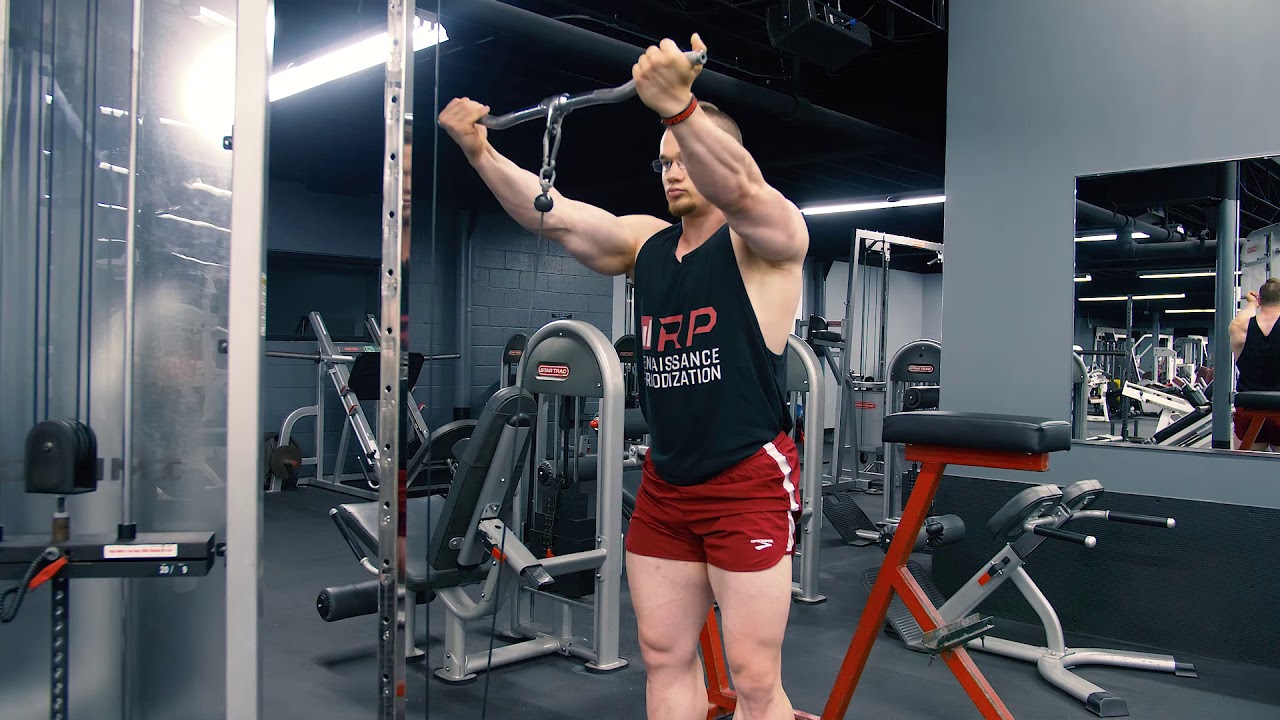The Power of Cable Back Exercises
When it comes to building a strong and defined back, incorporating cable exercises into your workout routine can take your gains to the next level. Cable machines offer a versatile and effective way to target various muscles in the back, helping you achieve a well-rounded and sculpted physique. In this comprehensive guide, we will explore a variety of cable back exercises, including the cable row exercise, cable lat exercises, and close grip seated cable row, among others. Get ready to unleash the potential of cable machines and transform your back with these expert-recommended workouts.
Understanding the Back Muscles and Cable Machine Workouts
Before diving into cable back exercises, it’s essential to understand the back muscles they target. The back is a complex group of muscles that can be divided into several regions:
- Latissimus Dorsi (Lats): The lats are the largest muscles in the back, responsible for giving the V-shape appearance. Cable lat exercises like the cable pull-down back and cable lats help target and strengthen these powerful muscles.
- Rhomboids: These muscles are located between the shoulder blades and play a vital role in shoulder stability. Cable row exercises, such as the close grip seated cable row, engage the rhomboids effectively.
- Trapezius (Traps): The traps are responsible for shoulder movement and neck support. Exercises like the back cable pull and rope pull-downs back can target the traps when done correctly.
- Erector Spinae: Located along the spine, the erector spinae muscles are crucial for maintaining an erect posture. Lower back cable exercises can engage and strengthen these muscles.
Effective Cable Back Exercises for a Strong Back
Now that we’ve explored the key muscles in the back, let’s delve into specific cable exercises that will help you sculpt a strong and defined back:
1. Cable Rows Workout: Cable rows are a fundamental back exercise that targets the lats, rhomboids, and traps. To perform cable rows, attach a straight bar to the low pulley of the cable machine. Stand facing the machine with knees slightly bent, then pull the bar towards your abdomen, squeezing your shoulder blades together. Slowly release and repeat for a complete cable rows workout.
2. Cable Lat Pulldowns: This exercise focuses on the lats, providing excellent isolation and development. Attach a wide grip handle to the high pulley and sit facing the cable machine. With an overhand grip, pull the handle down to your chest while keeping your back straight and elbows pointed downward. Return to the starting position and repeat for an effective cable lat pulldown back exercise.
3. Cable Pull-Throughs for Lower Back: Cable pull-throughs are a great way to engage your lower back muscles. Set the cable machine to a low pulley position, and stand facing away from the machine. Grab the rope handle between your legs and hinge at the hips, pushing your hips back until you feel a stretch in your hamstrings. Drive your hips forward to return to a standing position, engaging your lower back muscles in the process. Repeat for a challenging lower back cable exercise.
Cable Machine Back Exercises for a Sculpted Back
Let’s continue exploring more cable machine back exercises to target different areas of your back:

4. Cable Face Pulls: Cable face pulls are an excellent exercise for targeting the rear deltoids and upper back muscles. Set the cable machine to chest height with a rope attachment. Stand facing the machine and grasp the rope handles with an overhand grip. Pull the handles towards your face, keeping your elbows high and shoulder blades squeezed together. Slowly release and repeat for a cable face pull workout that enhances upper back strength and posture.
5. Cable Seated Rowing: The cable seated row is another variation of the cable row exercise, providing stability and control. Sit on the floor with your legs extended, and wrap the resistance band or cable around your feet. With an overhand grip, pull the handles towards your abdomen while keeping your back straight. Release slowly and repeat for an effective cable seated rowing exercise.
6. Cable Rope Back Workout: Incorporating the rope attachment into your cable exercises allows for a greater range of motion. One effective cable rope back workout is the cable rope face pull. Attach the rope to the high pulley and stand facing the machine. Pull the rope towards your face, separating the ends at the end of the movement. This exercise targets the rear deltoids and upper back.
Advancing Your Cable Back Workouts
As you become more proficient in cable back exercises, it’s essential to challenge yourself and progress further:
7. Arm and Back Workout with Cable Machine: Combine cable exercises that target both the arms and back for a comprehensive workout. For example, pair cable bicep curls with cable rows for an effective arm and back workout with the cable machine.
8. Cross-Cable Back Exercises: Utilize the crossover feature of the cable machine to perform cross-cable back exercises. Cross-cable lat pulldowns and cross-cable face pull engage multiple muscle groups simultaneously, leading to more efficient workouts.
Proper Form and Tips for Cable Back Workouts
To maximize the benefits of cable back exercises and reduce the risk of injury, keep the following tips in mind:
- Maintain a neutral spine throughout the movements to protect your back.
- Focus on the mind-muscle connection to ensure proper muscle engagement.
- Control the movements during both the concentric and eccentric phases of each exercise.
- Use an appropriate weight that allows you to perform each exercise in the correct form.
Remember to warm up before starting your cable back workouts and cool down afterward to promote blood flow and prevent muscle stiffness.
Unleash the Potential of Cable Back Workouts
Cable back exercises offer a dynamic and effective way to sculpt a strong and defined back. By targeting various muscles with a range of movements, you can achieve a well-rounded and balanced physique. Incorporate these cable machine back exercises into your workout routine, and progress over time to witness the transformative power of cable training.
Challenge yourself, stay consistent, and enjoy the journey as you develop a sculpted back that enhances your overall strength and athleticism. Remember to listen to your body, prioritize proper form, and consult with a fitness professional if needed.
Now, grab those cable handles and get ready to unleash the potential of cable back workouts. Achieve a powerful back and elevate your fitness journey to new heights!
Nutrition for Back Muscle Growth
To support your back muscle development and overall fitness goals, it’s essential to fuel your body with the right nutrients. Consider the following nutrition tips:
- Protein: Adequate protein intake is crucial for muscle repair and growth. Include lean sources of protein such as chicken, turkey, fish, tofu, eggs, and legumes in your diet.
- Healthy Fats: Incorporate healthy fats from sources like avocados, nuts, seeds, and olive oil to support overall health and hormone regulation.
- Complex Carbohydrates: Fuel your workouts with complex carbohydrates like whole grains, sweet potatoes, and fruits, providing sustained energy.
- Hydration: Stay hydrated throughout the day to support muscle function and recovery.
- Post-Workout Nutrition: Consume a post-workout meal or shake with a combination of protein and carbohydrates to aid muscle recovery.
Remember, proper nutrition complements your cable back workouts, optimizing your results and overall fitness progress.
Rest and Recovery for Back Muscles
As with any muscle group, rest and recovery are crucial for back muscles to grow and repair. Allow sufficient time between intense cable back workouts to prevent overtraining. Incorporate rest days into your training schedule and prioritize quality sleep to promote muscle recovery.
Tips for an Effective Cable Back Workout Routine
Take your cable back workouts to the next level with these additional tips:
- Warm-up: Prioritize a dynamic warm-up to increase blood flow and prepare your back muscles for the workout.
- Variation: Include different cable back exercises in your routine to target various muscle groups.
- Mind-Muscle Connection: Focus on engaging your back muscles during each movement, ensuring maximum muscle recruitment.
- Progressive Overload: Gradually increase the weight or resistance to challenge your back muscles and promote growth.
- Form Over Weight: Prioritize proper form over lifting heavy weights to prevent injuries and optimize muscle engagement.
Unlock the Strength of Your Back with Cable Workouts (Conclusion)
Congratulations! You’ve discovered the power of cable back exercises and how they can transform your back muscles. With a well-rounded cable back workout routine, proper nutrition, and ample rest, you’re on your way to sculpting a strong, defined, and powerful back.
Remember that fitness is a journey, and progress takes time and dedication. Stay consistent, challenge yourself, and embrace the process of growth and improvement. As you continue your fitness journey, always prioritize safety, listen to your body, and seek guidance from fitness professionals if needed.
Now, it’s time to unleash the strength of your back with cable workouts. Embrace the versatility of cable machines, and watch as your back muscles reach new heights of strength and definition. Get ready to stand tall, confident, and empowered with your sculpted back, setting the foundation for a healthier and stronger you!
Safety Precautions and Common Mistakes
While cable back exercises are highly effective, it’s essential to prioritize safety to prevent injuries. Avoid these common mistakes during your cable back workouts:
- Using Excessive Weight: Lifting too much weight can compromise your form and lead to strain or injury. Start with manageable weights and gradually increase as your strength improves.
- Neglecting Proper Form: Maintain proper posture and form throughout each exercise to target the intended muscles effectively and reduce the risk of injury.
- Jerking or Swinging: Avoid using momentum to lift the weights, as it takes the focus away from your back muscles and can strain other body parts.
- Overtraining: Allow sufficient rest and recovery between cable back workouts to give your muscles time to repair and grow.
- Ignoring Muscle Imbalances: Balance your back workouts with exercises that target other muscle groups, promoting overall muscular balance.
Incorporating Cable Back Workouts into Your Fitness Routine
Integrating cable back exercises into your existing fitness routine can be done seamlessly. Here’s how:
- Warm-up: Prioritize a full-body warm-up to prepare your muscles for the upcoming cable back exercises.
- Cable Back Workout: Follow the cable back exercises outlined earlier, targeting different areas of your back with proper form and control.
- Compound Movements: Supplement your cable back workouts with compound exercises like deadlifts and pull-ups, which also engage the back muscles.
- Cooldown and Stretching: After your cable back workout, perform stretches to promote flexibility and aid in muscle recovery.
Scaling the Cable Back Workouts
Cable back exercises can be adapted for various fitness levels:
- Beginners: Start with lighter resistance or bodyweight exercises to build a foundation of strength and proper form.
- Intermediate: Gradually increase the weight and incorporate more complex movements.
- Advanced: Challenge yourself with higher resistance, supersets, or advanced variations of cable back exercises.
A Strong Back for a Stronger You
A well-developed back not only enhances your physique but also improves posture, stability, and functional strength. With dedication, consistency, and the right cable back workouts, you’ll unleash the full potential of your back muscles and reach new heights in your fitness journey.
Remember, fitness is a continuous process of growth and self-improvement. Stay committed to your goals, embrace the challenges, and celebrate your progress along the way. Invest in your health and well-being by prioritizing cable back exercises and making them an integral part of your fitness routine.
Now, let’s put the power of cable back workouts into action and embark on a transformative journey toward a stronger, more confident you!
Unlocking Your Back’s Full Potential
To unlock your back’s full potential and achieve remarkable results with cable workouts, consider the following tips:
- Progressive Overload: Continually challenge your back muscles by increasing the resistance or the number of repetitions over time. Gradual progression stimulates muscle growth and strength gains.
- Mindful Training: Focus on the mind-muscle connection during cable back exercises. Visualize the targeted muscles working with each movement, enhancing muscle activation and efficiency.
- Variation is Key: Keep your workouts diverse and engaging by incorporating various cable back exercises. This approach ensures balanced muscle development and prevents plateauing.
- Periodization: Structure your cable back workouts into phases, varying intensity, and volume. Periodization optimizes muscle adaptation and minimizes the risk of overtraining.
Enhancing Back Workouts with Proper Nutrition
A well-rounded nutrition plan plays a pivotal role in supporting your back workouts and promoting muscle growth. Consider these nutritional tips:
- Protein Intake: Consume an adequate amount of protein to repair and build muscle tissue. Lean sources like chicken, turkey, fish, and plant-based options like beans and lentils are excellent choices.
- Carbohydrates for Energy: Include complex carbohydrates such as whole grains, fruits, and vegetables to fuel your workouts and maintain energy levels.
- Healthy Fats: Incorporate healthy fats from avocados, nuts, and olive oil for overall health and hormone regulation.
- Hydration: Stay well-hydrated to optimize performance and support muscle recovery.
- Pre- and Post-Workout Nutrition: Fuel your body with a balanced meal or snack before and after your cable back workouts to enhance muscle repair and recovery.
The Importance of Rest and Recovery
Allowing your back muscles time to rest and recover is vital for optimal results. Ensure you incorporate rest days in your workout schedule and prioritize quality sleep. During rest periods, your muscles rebuild and grow stronger.
Combining Cardiovascular and Strength Training
Incorporating cardiovascular exercises alongside your cable back workouts offers numerous benefits. Cardiovascular activities like running, cycling, or swimming improve heart health, increase endurance and promote fat loss. Integrating both forms of exercise ensures a well-rounded fitness routine.
Seeking Professional Guidance
If you’re new to cable-back workouts or have specific fitness goals, consider seeking guidance from a certified fitness trainer. They can design a personalized program tailored to your needs, ensuring proper form and progression.
Embracing the Journey
Achieving a strong and defined back through cable workouts requires dedication, patience, and consistency. Embrace the journey, and don’t be discouraged by setbacks. Celebrate your progress, both big and small, and focus on your commitment to a healthier and fitter lifestyle.
Unleash Your Back’s Potential
Congratulations! You’ve completed the ultimate guide to cable back workouts, equipping yourself with expert knowledge and exercises to sculpt a strong back. By incorporating cable row exercises, cable lat exercises, and other cable back variations into your routine, you’ll unleash your back’s full potential and achieve impressive results.
Remember, the key to success lies in staying consistent, challenging yourself, and fueling your body with the right nutrition. Whether you’re a beginner or an experienced fitness enthusiast, cable back workouts offer a versatile and effective way to enhance your physique, improve posture, and boost overall strength.
Now, seize the opportunity to unleash your back’s potential with cable workouts. Stand tall, confident, and empowered, knowing that you’ve taken a significant step toward a healthier, fitter, and stronger you!
Frequently Asked Questions (FAQs) About Cable Back Workouts
Q: Are cable back exercises suitable for beginners?
A: Yes, cable exercises can be adapted to different fitness levels. Start with lighter weights and focus on proper form before increasing the intensity.
Q: How many sets and reps should I do for cable back exercises?
A: Aim for 3-4 sets of 8-12 reps for each exercise, adjusting the weight according to your goals.
Q: Can I use resistance bands for cable back exercises?
A: Yes, resistance bands can be a great alternative to cable machines, providing similar benefits.
Q: Are cable back workouts suitable for beginners?
A: Yes, cable back workouts can be adapted for beginners. Start with lighter weights and focus on proper form.
Q: How often should I do cable back exercises?
A: It’s recommended to train your back muscles 2-3 times per week, with rest days in between.
Q: Can I replace cable back exercises with free weights?
A: While free weights are effective, cable back exercises offer unique benefits like constant tension and a full range of motion.
Q: What is the difference between wide grip and close grip cable rows?
A: Wide grip cable rows emphasize the lats, while close grip cable rows target the middle back and rhomboids.
Q: Should I perform cable back exercises before or after other workouts?
A: It’s best to perform cable back exercises earlier in your workout to prioritize muscle engagement and prevent fatigue.
Q: Can I do cable back exercises with an injury?
A: Consult a healthcare professional before exercising with an injury. They can recommend safe exercises and modifications.
Q: How long should a cable back workout be?
A: Aim for 30-45 minutes for an effective cable back workout, focusing on quality exercises and proper form.
Q: Can cable back exercises improve my posture?
A: Yes, strengthening your back muscles through cable exercises can improve posture and reduce the risk of back pain.
Q: Is it necessary to use a cable machine for back workouts?
A: While cable machines offer unique benefits, you can still perform effective back exercises with other equipment or resistance bands.
Q: Can I do cable back exercises on the same day as other muscle groups?
A: Yes, but avoid overtraining by allowing adequate rest between workouts and varying muscle groups.
Q: Are cable pull-downs better for lat development than pull-ups?
A: Both exercises are effective. Cable pull-downs offer more controlled resistance, while pull-ups engage additional stabilizing muscles.
Q: Can I target the lower back with cable exercises?
A: Yes, cable pull-throughs and cable face pulls can engage and strengthen the lower back muscles.
Q: How can I prevent shoulder pain during cable back exercises?
A: Maintain proper shoulder alignment and avoid using excessive weight. Focus on controlled movements to reduce strain on the shoulders.
Q: Should I do higher reps or heavier weights for cable back workouts?
A: Incorporate both higher reps and heavier weights into your routine to promote muscle growth and strength.
Q: Can I do cable back exercises with a resistance band?
A: Yes, many cable exercises can be adapted for resistance bands, making them suitable for home workouts.
Q: Can cable back exercises help me improve my deadlift?
A: Yes, cable back exercises strengthen the muscles used in deadlifting, contributing to improved performance.
Q: Is it necessary to use attachments for cable back exercises?
A: While attachments can add variety, some exercises can be performed with a simple handle or rope attachment.
Q: Can I combine cable back exercises with bodyweight exercises?
A: Yes, combining cable exercises with bodyweight movements like push-ups can create a comprehensive full-body workout.
Q: Should I do cable back exercises on consecutive days?
A: Avoid training the same muscle group on consecutive days to allow sufficient rest and recovery.
Q: How long will it take to see results from cable back workouts?
A: Results vary depending on individual factors, consistency, and nutrition. Visible results may take several weeks to months.






